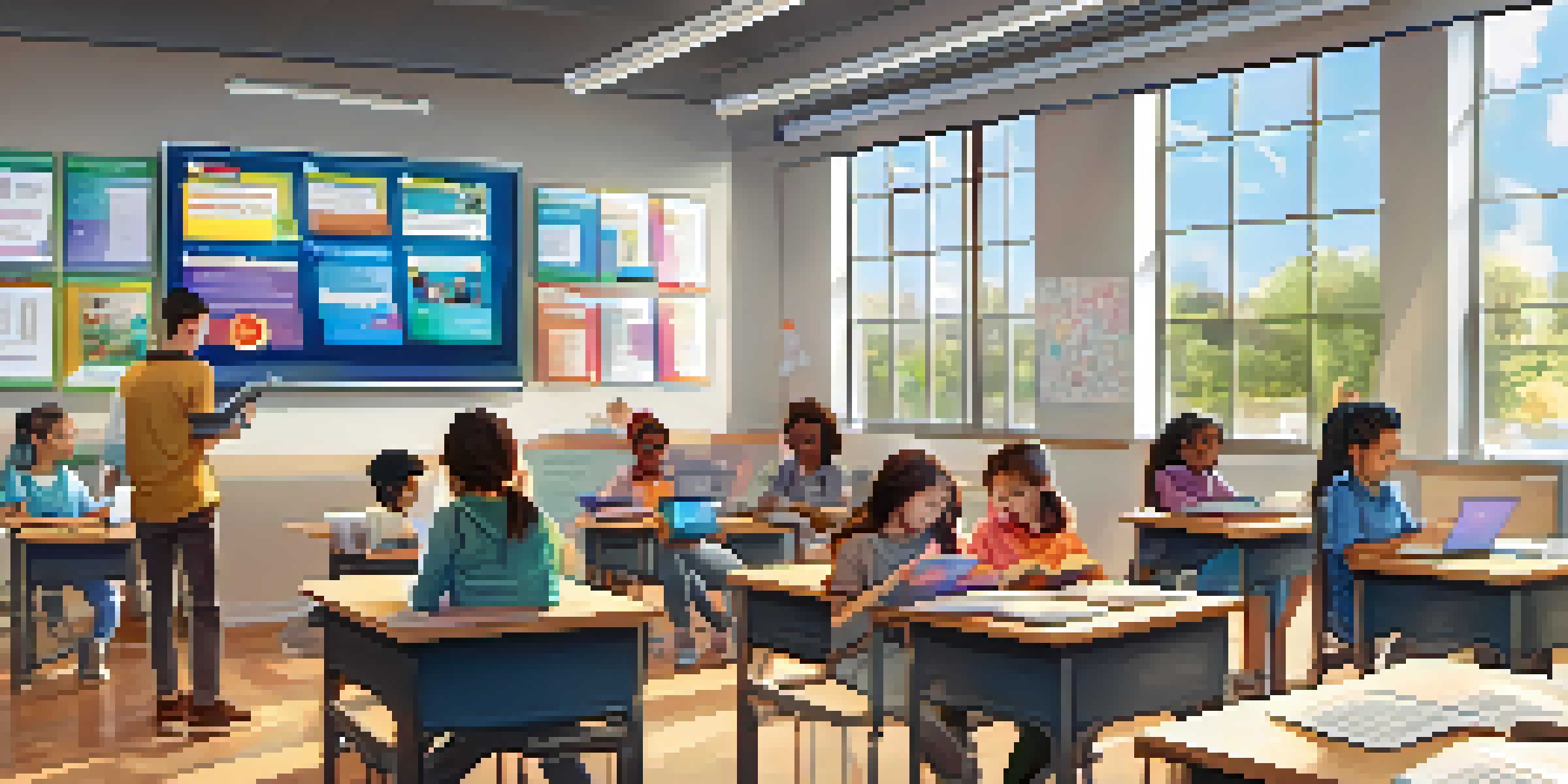The Future of Digital Textbooks in Education

The Shift from Traditional to Digital Learning Materials
In recent years, education has seen a significant transition from traditional textbooks to digital formats. This shift not only makes learning more accessible but also aligns with the increasing use of technology in classrooms. As students become more tech-savvy, they expect learning materials that reflect their digital lifestyles.
Education is the most powerful weapon which you can use to change the world.
Digital textbooks offer advantages such as interactive features, instant updates, and multimedia resources that enhance the learning experience. Imagine flipping through a textbook that includes videos, quizzes, and hyperlinks all in one place! This interactivity can cater to various learning styles, making education more engaging for all students.
Moreover, the environmental impact of reducing paper use cannot be overlooked. By embracing digital textbooks, educational institutions contribute to sustainability efforts while also cutting costs associated with printing and distribution. It's a win-win for both the planet and the budget.
Enhancing Accessibility for All Learners
One of the most significant benefits of digital textbooks is their potential to enhance accessibility for diverse learners. With features like adjustable text size, read-aloud options, and customizable backgrounds, these resources can cater to students with varying needs. This adaptability ensures that everyone has the tools to succeed.

For instance, a student with dyslexia might find it easier to engage with a digital textbook that allows them to change the font to a more readable style or listen to the content being read aloud. Such options can be a game changer in creating an inclusive learning environment where all students feel supported.
Digital Textbooks Enhance Learning
Digital textbooks provide interactive features and multimedia resources that cater to various learning styles, making education more engaging.
Additionally, digital textbooks can be accessed on multiple devices, from tablets to smartphones, ensuring that learning can happen anytime and anywhere. This flexibility is especially beneficial for students who may not have access to physical textbooks at home, promoting equity in education.
Interactive Learning: Engaging Students Like Never Before
Digital textbooks are not just static pages of text; they are rich, interactive platforms that engage students in new ways. With features like embedded quizzes, simulations, and discussion forums, students can actively participate in their learning process rather than passively consuming information. This interactivity promotes deeper understanding and retention of material.
The beautiful thing about learning is that no one can take it away from you.
Imagine a science textbook that allows students to conduct virtual experiments or a history book that includes interactive timelines. These engaging elements not only make learning more fun but also encourage critical thinking and collaboration among peers.
Moreover, teachers can utilize analytics from these digital platforms to track student progress, identify areas that need reinforcement, and tailor instruction accordingly. This data-driven approach enhances the educational experience for both educators and learners.
Cost-Effectiveness of Digital Textbooks
Cost is a major concern for both educational institutions and students. Digital textbooks often come at a fraction of the price of traditional books, making them a budget-friendly option. Furthermore, the ability to frequently update content means that schools can avoid costly reprints and ensure students have access to the most current information.
In addition to lower upfront costs, digital textbooks can also reduce expenses related to storage and distribution. Schools no longer need to allocate resources for physical space to store books or spend on shipping. This streamlined process allows funds to be redirected towards other essential educational needs.
Accessibility for Diverse Learners
These digital resources offer adjustable settings that support students with different needs, promoting an inclusive learning environment.
As educational budgets continue to be scrutinized, the affordability of digital textbooks becomes increasingly appealing. By making the switch, schools can provide quality resources while managing their finances more effectively.
The Role of Educators in Transitioning to Digital Textbooks
While digital textbooks hold great promise, their success largely depends on educators' willingness to embrace and integrate them into their teaching practices. Teachers play a vital role in guiding students through this transition, ensuring that they understand how to utilize digital resources effectively. Professional development opportunities can empower educators to become more comfortable with technology and online learning.
Moreover, educators can help tailor the digital learning experience to their students' needs, selecting resources that align with their curriculum and teaching style. Collaboration among teachers, tech support, and administrators is essential for a smooth transition, fostering an environment where everyone feels confident in using digital textbooks.
As teachers become more adept at using these tools, they can innovate their lesson plans, incorporating a blend of traditional and digital resources that enhance learning. This balanced approach allows for a richer educational experience that prepares students for a technology-driven future.
Challenges and Considerations in the Digital Textbook Era
Despite the many advantages, the transition to digital textbooks is not without challenges. Technical issues such as internet connectivity, device compatibility, and software updates can pose hurdles for both educators and students. It’s crucial to address these concerns to ensure that digital resources are accessible and functional for everyone.
Additionally, some students may experience screen fatigue or find it difficult to concentrate on digital screens for extended periods. Balancing screen time with traditional learning methods can help mitigate these issues, allowing students to benefit from both formats without overwhelming them.
Cost-Effective Educational Solution
Digital textbooks are often cheaper than traditional ones, reducing costs for schools while providing up-to-date content.
Finally, there is the question of digital equity. Not every student has access to the necessary technology at home, which could widen the educational gap. Schools must work together with communities to provide resources and support, ensuring that all students can thrive in a digital learning environment.
Looking Ahead: The Future of Digital Textbooks
As we look to the future, digital textbooks are poised to play a pivotal role in reshaping education. With advancements in technology, we can expect even more interactive features, personalized learning experiences, and integration with artificial intelligence. These innovations will further enhance the educational landscape, making learning more engaging and tailored to individual needs.
Moreover, the global shift towards remote and hybrid learning models has underscored the importance of flexible and adaptable resources. Digital textbooks will continue to evolve, meeting the demands of an ever-changing educational environment. Their ability to provide real-time updates and interactive content means they can easily adapt to new curricula and teaching methodologies.

In conclusion, the future of digital textbooks in education is bright. By embracing this shift, we can create a more inclusive, engaging, and effective learning experience for students across the globe.